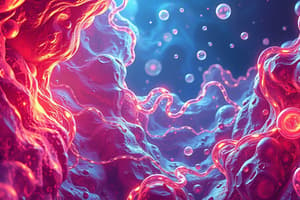Podcast
Questions and Answers
Which type of polymer is characterized by a long, straight chain structure?
Which type of polymer is characterized by a long, straight chain structure?
- Thermoplastic Polymer
- Linear Polymer (correct)
- Branched Polymer
- Crosslinked Polymer
What is the main difference between natural and synthetic polymers?
What is the main difference between natural and synthetic polymers?
- Natural polymers are synthesized by living organisms, while synthetic polymers are man-made. (correct)
- Natural polymers have lower molecular weight compared to synthetic polymers.
- Natural polymers are created in laboratories, while synthetic polymers are found in nature.
- Natural polymers are biodegradable, while synthetic polymers are not.
Which polymerization process involves the reaction of monomers and the release of small molecules?
Which polymerization process involves the reaction of monomers and the release of small molecules?
- Crosslinked Polymerization
- Condensation Polymerization (correct)
- Chain Growth Polymerization
- Addition Polymerization
What property of polymers is primarily influenced by molecular weight?
What property of polymers is primarily influenced by molecular weight?
Which type of polymer is permanently hardened after being set?
Which type of polymer is permanently hardened after being set?
What is the glass transition temperature (Tg) of a polymer?
What is the glass transition temperature (Tg) of a polymer?
Which of the following examples represents a natural polymer?
Which of the following examples represents a natural polymer?
What is a major environmental concern associated with synthetic polymers?
What is a major environmental concern associated with synthetic polymers?
Flashcards are hidden until you start studying
Study Notes
Definition of Polymers
- Polymers: Large molecules composed of repeating structural units (monomers).
- Monomers: Small, simple molecules that can join together to form polymers.
Types of Polymers
-
Natural Polymers:
- Examples: Proteins, nucleic acids, cellulose, rubber.
- Synthesized by living organisms.
-
Synthetic Polymers:
- Examples: Plastics (e.g., polyethylene, polystyrene), nylon.
- Man-made through chemical processes.
Polymer Classification
-
By Structure:
- Linear Polymers: Long, straight chains (e.g., PVC).
- Branched Polymers: Chains with side branches (e.g., low-density polyethylene).
- Crosslinked Polymers: Chains interconnected (e.g., vulcanized rubber, epoxy).
-
By Thermal Behavior:
- Thermoplastics: Soften upon heating and can be reshaped (e.g., PET).
- Thermosetting Polymers: Harden permanently after being set (e.g., bakelite).
Polymerization Processes
-
Addition Polymerization:
- Initiator adds to monomer, creating a long chain.
- No by-products.
- Example: Ethylene to polyethylene.
-
Condensation Polymerization:
- Monomers react and release small molecules (usually water).
- Example: Formation of nylon from dicarboxylic acid and diamine.
Polymer Properties
- Molecular Weight: Influences physical properties (strength, elasticity).
- Crystallinity:
- Crystalline regions (ordered structure) vs. amorphous regions (disordered structure).
- Affects melting point and transparency.
Applications of Polymers
- Packaging: Lightweight, versatile, often recyclable (e.g., plastic bags, containers).
- Textiles: Fibers for clothing, upholstery (e.g., polyester, nylon).
- Biomedical: Drug delivery systems, sutures, implants (e.g., biocompatible polymers).
- Construction: Materials with durability and insulation properties (e.g., PVC pipes).
Key Concepts
- Degree of Polymerization: The number of repeating units in a polymer.
- Glass Transition Temperature (Tg): Temperature at which a polymer transitions from hard and brittle to rubbery.
- Mechanical Properties: Tensile strength, elasticity, toughness, influenced by molecular structure.
Environmental Impact
- Biodegradable Polymers: Designed to break down more quickly in the environment (e.g., polylactic acid).
- Microplastics: Small plastic particles causing environmental pollution.
Current Research Areas
- Smart Polymers: Responsive materials that change properties based on external stimuli (e.g., pH, temperature).
- Nanocomposites: Polymers combined with nanoscale materials to enhance properties.
Polymer Definition & Types
- Polymers are large molecules made of repeating units called monomers.
- Monomers are small, simple molecules.
- Natural polymers are synthesized by living organisms (e.g., proteins, cellulose).
- Synthetic polymers are man-made (e.g., plastics, nylon).
Polymer Structure & Thermal Behavior
- Linear polymers have long, straight chains (e.g., PVC).
- Branched polymers have side chains (e.g., low-density polyethylene).
- Crosslinked polymers have interconnected chains (e.g., vulcanized rubber).
- Thermoplastics soften upon heating and can be reshaped (e.g., PET).
- Thermosetting polymers harden permanently after initial setting (e.g., bakelite).
Polymerization Processes
- Addition polymerization involves a chain reaction with no byproducts (e.g., ethylene to polyethylene).
- Condensation polymerization involves monomers reacting, releasing small molecules like water (e.g., nylon formation).
Polymer Properties & Applications
- Molecular weight affects polymer strength and elasticity.
- Crystallinity (ordered vs. disordered structure) influences melting point and transparency.
- Polymers are used widely in packaging, textiles, biomedical applications, and construction. Examples include plastic bags, polyester clothing, and PVC pipes.
Key Concepts & Environmental Impact
- Degree of polymerization is the number of repeating units in a polymer chain.
- Glass transition temperature (Tg) is the temperature where a polymer transitions from hard/brittle to rubbery.
- Mechanical properties (tensile strength, elasticity, toughness) depend on molecular structure.
- Biodegradable polymers break down more easily in the environment (e.g., polylactic acid).
- Microplastics are tiny plastic particles causing environmental pollution.
Current Research
- Smart polymers change properties in response to external stimuli (e.g., pH, temperature).
- Polymer nanocomposites combine polymers with nanoscale materials for enhanced properties.
Studying That Suits You
Use AI to generate personalized quizzes and flashcards to suit your learning preferences.




